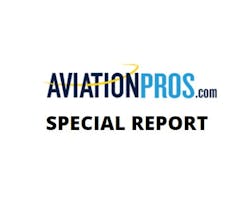What the Latest Update to ATA 103 Means for Fuel Handlers

Airlines for America recently announced it is modifying its ATA 103 standard for jet fuel quality control at airports to immediately allow the use of water barrier filters.
Bulletin 2022.1 notes water barrier filters meeting EI 1588 qualifications are an acceptable replacement for filter monitors that utilize super absorbent polymers (SAP).
Filter monitors containing SAP are being phased out of the industry after an IATA Special Interest Group was made aware of multiple incidents where the presence of SAP in engine/airframe fuel system components had been confirmed. The Special Interest Group determined “the continued use of filter monitor filtration systems in aviation fuel handling is incapable of reliably meeting the aircraft and engine operating requirements.”
Water barrier filters are now the second replacement technology for filter monitors accepted by ATA 103.
“Monitors were very popular for many years,” said Steve Berry, manager of fuel quality and safety at the National Air Transportation Association (NATA), who will be part of a webinar Wednesday to further educate the industry on this update.
“The process for developing and qualifying a new filtration technology takes years of thorough research and development to make sure that those technologies meet the exacting specifications that we require of aviation fuel filtration. So, it's not like you can just flip the switch and come up with an entirely new solution.”
ATA 103 offers a formal mechanism for into-plane fuel providers that have adopted the ATA 103 standard to start using water barrier filters that meet EI 1588 qualifications, Berry explained.
“There's an important distinction to make when we're talking especially to a GA audience,” Berry said. “The ATA 103 has sort of become the de facto standard that everybody references to standard specification for jet fuel quality control in the United States. But it's only enforceable to the extent that somebody adopts it.
“It's adopted and recognized by the airlines. But there are lots of folks in the GA market that also use the ATA 103.”
Accepted Replacements
If fuel handlers have monitor filters on their truck or are using a filter monitor vessel with SAP filter monitors, Berry explained there are three alternative solutions available to date.
“The first one and the one people haven't really been moving to, because it's cost prohibitive, is to replace that monitor vessel with the filter water separator that meets EI 1581 qualification. So, number one that's expensive cause you're basically going with an entirely new filter vessel and an entirely new set up, but it's also – in some applications – just not possible to use,” Berry said, using hydrant carts that are much smaller relative to fuel trucks, as an example.
Another option is to keep the same filter monitor vessel and utilize a dirt defense filter that meet EI 1599 criteria and then equip the system with an electronic water sensor that meets EI 1598 requirements.
“That is also acceptable in the 103 and other international standards,” Berry said. “It's a solution that some have already adopted, especially outside of the United States. But it works a little bit differently whereas a filter monitor with a single cartridge or a single element was able to address both free water and particulate. The dirt defense is only able to filter particulate and then it relies on a downstream sensor – the electronic water sensor – that can detect water and then it essentially shuts down the fueling operation if water is detected.”
Water barrier filters qualified to EI 1588 are now the third option.
“It serves as a true drop-in replacement,” Berry said. “Right now, the 1588 is qualifying the 2” water barrier filters. Those water barriers, you can fit into existing filter monitor vessels and they protect against both particulate and against water. And then they don't require any downstream modifications and you don't have to replace filter vessels and so it's an attractive design option.”
While filter monitors were designed to absorb water to keep fuel dry, water barrier filters repel water.
“The barrier media is able to repel free water and block any solids or particulate contamination from moving downstream,” Berry explained. “The media is hydrophobic.”
Bulletin 2022.1
Berry will discuss the A4A’s Bulletin 2022.1 and water barrier filters with Amy Carico, director of fuel services and technical standards at A4A, and Rob Guglielmi, global business development manager for Parker Hannifin Corporation’s Aerospace Filtration Division during a webinar Wednesday, Feb. 23 at 2 p.m. (EST).
Berry said the webinar will offer background on the topic and provide details about what water barrier filters are and how they came to be. There are also significant differences in approach when dealing with water barrier filters versus a filter monitor or filter water separator.
“There's some changes in the way that we traditionally approach some of our operational aspects when it comes to differential pressure and things like that,” Berry added.
The webinar aims to address what the changes mean for into-plane fuel providers. Berry encouraged NATA members, those offering into-plane refueling operation and anyone who has a stake in refueling aircraft to attend.
“They could be from the GA side of the house or the commercial side of the house,” Berry said. “This issue touches, really, the entire industry. It doesn't matter what your customer base is, if you are refueling aircraft then this is going to affect you.”
More information about the webinar and registration can be found here.
About the Author
Josh Smith
Editor
Josh Smith served as editor of Ground Support Worldwide as editor from 2016 through 2024. He oversaw production of the print magazine, created GSW's newsletters on a daily basis, and updated the latest news on AviationPros.com.
